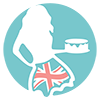0:00
Yes, you can double or triple a cake recipe to make a larger cake, but it's not quite as easy as that
0:06
Avoid overbaking, domed tops, crumbling cake layers and cracked frosting with these tips and tricks
0:14
and stay tuned for a competition. With such big layers, it's common for the cake to be overbaked around the edges and still raw in the middle
0:26
To prevent that, you can do three things. Divide the batter between more pans so that each layer is thinner and cooks more quickly and more evenly
0:36
Use a flour nail in the middle of the pan. These are usually used for piping flowers, but instead turn it upside down so that the flat head is resting on the pan and the pin is pointing upwards
0:48
You can put this in the pan before pouring your batter in, or after adding the batter, push it through the batter down to the bottom of the pan
0:56
As the oven heats up the pan, that heat will pass through the flower nail up through the pin
1:01
and that will help the middle of the cake bake as quickly as the outside of the cake
1:06
For big cakes reduce your baking temperature slightly only by 10 or 25 degrees so that the cake bakes more slowly and that way it will bake more evenly If your cakes don rise evenly as they bake they have domed tops
1:20
and when your cakes are so big, that means a lot of wasted cake
1:25
Prevent domes with baking strips. For large pans, you'll need to use two strips attached together
1:30
by looping the end of one through one of the tabs of the other. Adjust them to fit the pan and then soak them in water for 10 minutes
1:38
Squeeze out most of the water and then wrap them around the cake pan before you put it into the oven
1:44
It will take about 10 minutes longer for the cake to bake when it's wrapped with baking strips
1:48
but it will rise higher and it will be evenly baked without burnt edges
1:53
After baking small cakes, it makes sense to flip the pans upside down
1:58
to turn the cakes out onto a cooling rack. That would be brave or foolish with big cakes, so instead try this
2:06
Place the cooling rack on top of the cake pot. and then grip onto the rack and the pan and flip them over together
2:13
Lift the pan up and voila! Cakeboards for big cakes will have to be wider but also thicker
2:20
Use a cake drum for 10-inch cakes and bigger. Cake drums are thicker and stronger which is important because big cakes are much heavier and any movement of the cake board if it bends or buckles under the weight of the cake will cause the frosting to crack
2:37
When you move cake layers at room temperature, they're much more delicate than when they're cold
2:42
so when you move them from the cooling rack, it's a good idea to use a cake lifter
2:46
These are large squares of metal that provide a big surface to support a big cake
2:53
When you're spreading on your filling and later you're frosting, use a long offset spatula
2:59
You might have smaller ones for smaller cakes, usually a 9 inch long one for small cakes like a 4 inch or a 6 inch cake
3:06
but once you get to the bigger cakes, 10 inch, 12 inches, you really need a longer offset spatula
3:11
And when you're choosing your size, just make sure that the length of the blade
3:15
from the tip to the base, reaches from the middle of your cake over the outer edge
3:21
Also make sure that your cake comb is tall enough. It needs to be at least as tall as the cake so that you can get straight
3:28
smooth frosting. After frosting the cake, make sure any decorations are to scale. For example
3:35
buttercream transfers for characters will need to be much larger on larger cakes than on smaller cakes
3:41
so that they to scale And you need to prepare about three times as much drip for a 12 cake compared to a six cake Of course you need more filling and more frosting for larger cakes than small
3:53
cakes, but you'll also need more buttercream for stencils and piping. How much do you think this
3:59
cake weighs? Here comes the competition. If you've watched my other videos, you'll know I have an
4:04
online cake school where I teach how to decorate cakes. I'm excited to share a brand new program called Layer Up
4:10
where you work through three layers to go from beginner cake decorating, like perfecting smooth frosting
4:17
getting more advanced like mastering piping and stenciling and learning how to work with chocolate and wafer paper and acetate
4:24
until you can make professional-looking cakes that will blow people away and if you sell your cakes
4:29
you'll be able to charge a lot more for them. So, how much does this cake weigh
4:34
It was too heavy for my kitchen scale to handle, so I used a bathroom scale and
4:39
wow, it was even heavier than I thought. Put your guess in the comments and the closest guess
4:44
will win an annual membership to my layer up program. Write your guess in the comments and check
4:49
the video description for more details. You can visit my cake school on Britishgirlbakes.com


